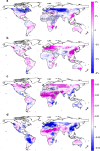Impacts of solar intermittency on future photovoltaic reliability
- PMID: 32963258
- PMCID: PMC7508863
- DOI: 10.1038/s41467-020-18602-6
Impacts of solar intermittency on future photovoltaic reliability
Abstract
As photovoltaic power is expanding rapidly worldwide, it is imperative to assess its promise under future climate scenarios. While a great deal of research has been devoted to trends in mean solar radiation, less attention has been paid to its intermittent character, a key challenge when compounded with uncertainties related to climate variability. Using both satellite data and climate model outputs, we characterize solar radiation intermittency to assess future photovoltaic reliability. We find that the relation between the future power supply and long-term mean solar radiation trends is spatially heterogeneous, showing power reliability is more sensitive to the fluctuations of mean solar radiation in hot arid regions. Our results highlight how reliability analysis must account simultaneously for the mean and intermittency of solar inputs when assessing the impacts of climate change on photovoltaics.
Conflict of interest statement
The authors declare no competing interests.
Figures





References
-
- Fripp M. Switch: a planning tool for power systems with large shares of intermittent renewable energy. Environ. Sci. Technol. 2012;46:6371–6378. - PubMed
-
- He G, et al. SWITCH-China: a systems approach to decarbonizing China’s power system. Environ. Sci. Technol. 2016;50:5467–5473. - PubMed
-
- Perez R, et al. Achieving very high PV penetration—the need for an effective electricity remuneration framework and a central role for grid operators. Energy Policy. 2016;96:27–35.
-
- Northwest China Energy Regulatory. Regulation for grid-connected power plants in Northwest regions. http://xbj.nea.gov.cn/website/Aastatic/news-196276.html (2018).
-
- Ying, L. Northwest photovolatic power plants received $0.27 billion ticket for the first half year of 2019. CNGOLDhttps://energy.cngold.org/c/2019-09-19/c6584966.html (2019).
Grants and funding
- 41877158/National Natural Science Foundation of China (National Science Foundation of China)
- 51739009/National Natural Science Foundation of China (National Science Foundation of China)
- EAR-1316258/National Science Foundation (NSF)
- FESD EAR-1338694/National Science Foundation (NSF)
- 58-6408-3-027/United States Department of Agriculture | Agricultural Research Service (USDA Agricultural Research Service)
LinkOut - more resources
Full Text Sources
Research Materials

